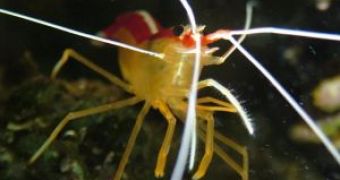When your man is not accomplishing his "house duties", could it be PMS ?
Medics describe a men menopause (called andropause) just like women's, when decreased levels of sexual hormones (testosterone) cause a decreased sexual activity and libido, decrease of muscle volume, and many other symptoms.
But now it appears that there are males that can go through a form of menstruation, too.
Male shrimp undergo a menstrual-like cycle of reproductive readiness and renewal, in which they purge their tired old sperm and replace it with a fresh batch, as a new study found.
This is the first time males of any species have been found to refresh sperm in the same way as females refresh eggs to prepare for pregnancy.
Dr Shmuel Parnes and colleagues at Israel's Ben-Gurion University looked for signs of sperm turnover in saltwater shrimp over 32 weeks.
In this species, aging sperm can be recognized because a brown pigment accumulates in the sperm packets, known as spermatophores, which are clearly visible in the shrimp.
But a few hours before moulting, they can no longer be seen.
That was the only time, except immediately after mating, that spermatophores were absent.
However, sperm is stored in vessels that are positioned outside the body, where they are not protected by the immune system and that's why they may degrade over time.
As they are near their "use-by" date, then, it should in theory be to an animal's advantage to discard them most rapidly possible.
"There is no evidence as yet that such cycles occur in men," says Dr Parnes.
But few biologists have ever investigated this phenomenon, so the process might be much more common than first thought.
Biologists have biased to focus on the more obvious reproductive cycles of females, believing that nothing similar occurs in males - in part because males tend not to undergo dramatic and obvious physiological changes.
"The thought is that males are always ready," says Ernest Chang, a comparative physiologist at the Bodega Marine Laboratory of the University of California, Davis.

 14 DAY TRIAL //
14 DAY TRIAL //